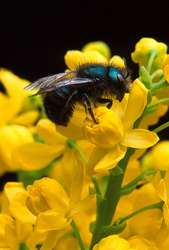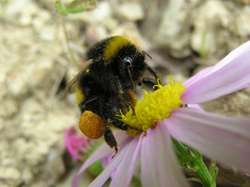Studies find wild bees and insects essential to food security

Wild pollinators – primarily wild bees, flies, and other insects – are at least as important, and often more efficient, at pollinating agricultural crops than domestic honey bee colonies, according to two new studies published in Science and the Proceedings of the National Academies of Sciences.
"This will be a surprise to the agricultural establishment," said Rachael Winfree, professor of ecology, evolution and natural resources in Rutgers' School of Environmental and Biological Sciences, who was involved in both studies. "There's a widespread assumption that domestic honeybees are doing the job. This work shows that's not true."
The first study, published in Science, involved 51 researchers from 20 countries on every continent but Antarctica, who visited 600 fields, in which grew 41 varieties of crop. It was led by Lucas Garibaldi of the National University of Rio Negro in Argentina.
About 75% percent of food crops require pollination, making pollinators an essential part of food security. The researchers found that almost half that pollination is the work of wild pollinators.

The good news is that farmers can keep wild pollinators abundant by leaving a bit of natural habitat around their fields – patches of wildflowers, some hedge rows or anything that gives wild bees a place to live, Winfree said. "Farms with a little bit of natural habitat are more sustainable in terms of their pollination," she said. She added that farms using pesticides and insecticides tend to have fewer pollinators than those that don't.
The second study, published in PNAS, examined historical changes in the population of wild bees in the northeastern United States and southern Canada. Winfree and Ignasi Bartomeus, then a postdoctoral scholar in her lab; John Ascher, a scientist at the American Museum of Natural History in New York; and others employed web-based software to compile 30,000 museum specimen records representing 438 bee species.
The researchers looked at "species richness" – the number of species of bee in a specific region—and how it changed over time. They used museum records, going back to 1872. They found that wild bees as a whole had suffered some species losses but that these declines were moderate – about 15 percent of the more than 400 species over the 140 years.
Bumble bee colonies, on the other hand, are disappearing. Since 1872, according to the PNAS study, the number of bumble bee species in the northeastern United States and southern Canada has declined about 30 percent.
Since, as Winfree and her many co-authors found in their Science paper, wild pollinators are key to successful pollination of agricultural crops, a 30 percent loss in species richness is bad news. This is especially true of bumble bees. "They're very important," Winfree said. "They're big and hairy and carry a lot of pollen."
While the PNAS paper doesn't offer reasons for the loss in species richness for bumble bees or other bees, the authors point out that non-native species of wild bees seem to be doing better than those native to North America. There is some indication that climate change may play a role, since bees long associated with the south seem to be moving north.
"Environmental change affects species differentially," said Bartomeus, now a postdoctoral scholar at the Swedish University of Agricultural Sciences in Stockholm. "It creates 'losers' that decline with increased human activity, but also 'winners' that thrive in human-altered environments."
Journal information: Science , Proceedings of the National Academy of Sciences
Provided by Rutgers University



















